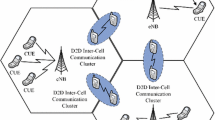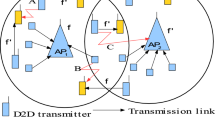Abstract
A large number of new data consuming applications are emerging in the daily routines of mobile users. Device-to-Device (D2D) communication as a new paradigm is introduced to reduce the increasing traffic and offload it to the user equipment (UE). With the development of UE multi-radio interface, we first develop a new hybrid architecture concept for D2D communication. The architecture combines ISM 2.4G spectrum as the Out-Band mode using Bluetooth and Wifi-Direct with the cellular spectrum as the In-Band mode. Secondly, we design a scheme that forms the Out-Band cluster and makes the following periodic signaling interaction via the Bluetooth interface. Traffic is transferred via the Wifi-Direct interface inside the cluster but carried on the cellular spectrum among the clusters. Simulation results show that our proposal increases the system throughput, saves power consumption and prolongs the clusters lifetime.











Similar content being viewed by others
References
Boccardi F, Heath RW, Lozano A, Marzetta TL, Popovski P (2014) Five disruptive technology directions for 5G. IEEE Commun Mag 52(2):74–80
Asadi A, Wang Q, Mancuso V (2013) A survey on Device-to-Device communication in cellular networks. IEEE Commun Surveys Tutorials 18
Xiaofei W, Min C, Taleb T, Ksentini A, Leung V (2014) Cache in the air: exploiting content caching and delivery techniques for 5G systems. IEEE Commun Mag 52(2):131–139
Xinzhou W, Tavildar S, Shakkottai S, Richardson T, Junyi L, Laroia R, Jovicic A (2010) FlashLinQ: A synchronous distributed scheduler for peer-to-peer ad hoc networks. In: 48th annual Allerton conference on communication, control, and computing (Allerton), Allerton. pp 514–521
IEEE, Std 802.11-2012: Wireless LAN Medium Access Control (MAC) and Physical Layer (PHY) Specifications, (2012)
Huang J, Qian F, Gerber A, Mao ZM, Sen S, Spatscheck O (2012) A close examination of performance and power characteristics of 4g lte networks. pp 225–238
McDermott-Wells P (2005) What is Bluetooth? Potentials. IEEE 23(5):33–35
Kaufman B, Aazhang B (2008) Cellular networks with an overlaid device to device network. In: 42nd Asilomar conference on signals, systems and computers, Pacific Grove. pp 1537–1541
Tao P, Qianxi L, Haiming W, Shaoyi X, Wenbo W (2009) Interference avoidance mechanisms in the hybrid cellular and device-to-device systems. In: IEEE 20th international symposium on personal, indoor and mobile radio communications, Tokyo. pp 617–621
Rongqing Z, Xiang C, Liuqing Y, Bingli J (2013) Interference-aware graph based resource sharing for device-to-device communications underlaying cellular networks. In: IEEE Wireless communications and networking conference (WCNC), Shanghai. pp 140–145
Shaoyi X, Haiming W, Tao C, Qing H, Tao P (2010) Effective interference cancellation scheme for Device-to-Device communication underlaying cellular networks. In: IEEE 72nd vehicular technology conference fall (VTC 2010-Fall), Ottawa. pp 1–5
Chia-Hao Y, Tirkkonen O (2012) Device-to-Device underlay cellular network based on rate splitting. In: IEEE wireless communications and networking conference (WCNC), Shanghai. pp 262–266
Osseiran A, Doppler K, Ribeiro C, Xiao M, Skoglund M, Manssour J (2009) Advances in device-to-device communications and network coding for IMT-advanced. ICT Mobile Summit
Minchae J, Kyuho H, Sooyong C (2012) Joint Mode Selection and Power Allocation Scheme for Power-Efficient Device-to-Device (D2D) Communication. In: IEEE 75th vehicular technology conference (VTC Spring), Yokohama. pp 1–5
Belleschi M, Fodor G, Abrardo A (2011) Performance analysis of a distributed resource allocation scheme for D2D communications. In: IEEE GLOBECOM workshops (GC Wkshps), Houston. pp 358–362
Bin Z, Honglin H, Sheng-Qiang H, Hsiao-Hwa C (2013) Intracluster device-to-device relay algorithm with optimal resource utilization. IEEE Trans Veh Technol 62(5):2315–2326
Li JCF, Ming L, Feifei G (2012) Device-to-device (D2D) communication in MU-MIMO cellular networks. In: IEEE global communications conference (GLOBECOM), Anaheim. pp 3583–3587
Fodor G, Dahlman E, Mildh G, Parkvall S, Reider N, Miklo X, S G, Tura X, Nyi Z (2012) Design aspects of network assisted device-to-device communications. IEEE Commun Mag 50(3):170–177
Alliance W (2010) Wi-Fi Peer-to-Peer (P2P) Specification v1.1, Wi-Fi Alliance Specification, vol 1. pp 1–159
Bluetooth. S (2001) Bluetooth specification version 1.1,” Available HTTP: http://www.bluetooth.com
Alliance Z (2006) Zigbee specification, Document 053474r06, Version, vol 1
Bin Z, Saisai M, Jing X, Zhenhong L (2013) Group-wise channel sensing and resource pre-allocation for LTE D2D on ISM band. In: IEEE wireless communications and networking conference (WCNC), Shanghai. pp 118–122
Asadi A, mancuso V (2013) Energy efficient opportunistic uplink packet forwarding in hybrid wireless networks. The fourth international conference on future energy systems, pp 261–262
Asadi A, Mancuso V (2013) On the compound impact of opportunistic scheduling and D2D communications in cellular networks. In: Proceedings of the 16th ACM international conference on Modeling, analysis and simulation of wireless and mobile systems, Barcelona, Spain, 2013, ACM. pp. 279–288
Asadi A, Mancuso V (2014) Dronee: Dual-radio opportunistic networking for energy efficiency. Comput Commun:23–28
Asadi A, Mancuso V (2013) WiFi Direct and LTE D2D in actionWireless Days (WD), 2013 IFIP, Valencia. pp 1–8
Hong J, Park S, Kim H, Choi S, Lee KB (2013) Analysis of Device-to-Device discovery and link setup in LTE networks. In: IEEE 24th international symposium on personal indoor and mobile radio communications (PIMRC), London, United Kingdom. pp 2856–2860
Balani R (2007) Energy consumption analysis for Bluetooth, Wi-Fi and cellular networks. Technical Report, Department of Electrical Engineering, University of California at Los Angeles, California, USA
Xiang L, Ge X, Wang CX, Li FY, Reichert F (2013) Energy efficiency evaluation of cellular networks based on spatial distributions of traffic load and power consumption. IEEE Trans Wirel Commun 12(3):961–973
Chen W-Y, Wu J-LC, Shin H-Y (2007) Performance analysis of radio resource allocation for multimedia traffic in cellular networks. J Internet Techn 8(4):505–514
Acknowledgments
The work presented in this paper was partially supported by 2012 National Natural Science Foundation of China (Grant number 61172097), 2014 National Natural Science Foundation of China (Grant number 61371081), 2013 Science Technology Key Project of Fujian (Grant number 2013H0048), and 2013 Science Technology Project of Xiamen (Grant number 3502Z20131155).
Author information
Authors and Affiliations
Corresponding authors
Rights and permissions
About this article
Cite this article
Lin, Z., Gao, Z., Huang, L. et al. Hybrid Architecture Performance Analysis for Device-to-Device Communication in 5G Cellular Network. Mobile Netw Appl 20, 713–724 (2015). https://doi.org/10.1007/s11036-015-0566-7
Published:
Issue Date:
DOI: https://doi.org/10.1007/s11036-015-0566-7




